Abstract
Various unmanned aerial vechicle (UAV) applications, especially those based on reconnaissance and observation missions, often require an unlimited time of flight. This is possible only when a UAV is continuously supplied with power from a ground-based power source, which is why tethered UAV systems were developed. Tethered UAV systems are based on multicopters, which can hover above a landing pad or track its position if it is movable. The presented research concerned the development of a large C3 class hexacopter with a maximal payload of about 1 kg and a takeoff mass of 16 kg, which was tested in maritime conditions during a ferry’s cruise. The main purpose of the hexacopter was to continuously observe the area ahead of the vessel to detect and localize obstacles in the water. During the experimental tests, critical phases of flight were identified, the AC/DC power supply unit and power cord unwinder were tested, and the power required by six brushless direct current (BLDC) motors was registered. The obtained results could be useful in future work on tethered UAV systems applied in windy maritime conditions.
1. Introduction
The usage of UAVs (unmanned aerial vehicles) in vessel-based missions has risen significantly due to their ability to provide an effective platform for numerous purposes. With enhancements made to aerial vehicles’ technology and sensor miniaturization, UAVs have emerged as significant contributors towards maritime activities. These unmanned planes provide superior situational awareness alongside seamless data collection capabilities, which make them much more affordable than conventional techniques.
The most common applications of UAV systems are focused chiefly on observation and reconnaissance missions [1]. It is obvious that advanced vision systems and flights at a hundred meters above the ground significantly increase the range of visual observation. This can be proven by drone usage in modern wars, where identifying enemy positions is crucial in a successful strike [2]. Drones and their vision systems are excellent tools for monitoring national borders [3] or forests to protect against fires [4]. Another possibility for UAV observations, which can be a challenge, is to recognize and localize objects on the surface of water that could be dangerous to a vessel’s structure [5,6]. This is especially important if future vessels are unmanned, considering the great number of containers lost at sea. To prevent unexpected collisions, monitoring should be continuous, with a range of view sufficient for the performance of avoidance maneuvers. This could be possible with a UAV that is continuously supplied with power from the deck of the vessel and with a flight altitude of at least 50 m. Therefore, the current paper focuses on such a UAV, i.e., a tethered multicopter whose payload is sufficient for mounting advanced cameras. This paper presents flight tests of the tethered multicopter in maritime conditions during a standard cruise of the “Wolin” ferry over the Baltic Sea. The test results, which are a combination of the observations and recorded flight parameters, can be used to identify potential issues of UAV usage in maritime conditions on the deck of a vessel, especially related to wind gusts and turbulence over the helipad. This paper presents the results for the UAV’s operation in sea conditions. The UAV was developed based on the conclusions and invaluable experience drawn from tests in quasi-real conditions carried out on a lake, which were presented in [7].
This article consists of six sections. The first is the introduction, with a subsection containing a review of current advances in tethered UAV systems. The second contains a detailed description of the designed tethered hexacopter system, including separate subsections, sequentially, about the tethered hexacopter, the power cord unwinder, the equipment required for the tracking of the helipad’s position, and the ultra-wideband (UWB) positioning system. In the third section, the experimental tests, performed flight missions, and weather conditions during the ferry’s cruise over the Baltic Sea are presented. The last two sections are dedicated to a discussion of the results and final conclusions, respectively.
Current Advances in Related Research
Unmanned aerial vehicles (UAVs) are a transformative technology showing tremendous promise for several sectors, one of which is the maritime industry. A closer analysis reveals a range of perks offered by these vehicles: the efficient retrieval of data streams and advanced surveillance standards, preserving public safety while substantially cutting costs for operators. Nevertheless, many impediments need to be overcome before this budding technology can be fully deployed in mission-critical tasks involving vessels: regulations on multiple levels, limited technical capacities, and adverse operating circumstances all pose formidable challenges. In order to achieve the maximum potential in marine-based application scenarios, it is essential that related issues are addressed comprehensively.
Over the course of several consecutive years, numerous research teams have dedicated their efforts to overcome various challenges associated with operating UAVs in maritime conditions. The constraints imposed by limited resources such as specialists, work hours, and available deck space on ships and boats pose major challenges. Consequently, engineers have been compelled to develop autonomous systems that are both maintenance-free and reliable. Nevertheless, the creation of fully autonomous solutions that can be used in commercial applications has proved to be exceedingly expensive and financially unfeasible for many companies and research institutions. As a result, progress has been made incrementally within specific domains of expertise.
One of the main applications of the UAV in maritime conditions is photogrammetry, which is a technique to create detailed and accurate 3D maps using aerial photography. The development and evolution of the UAV in terms of operational costs and reliability have substantially increased the accessibility and efficiency of photogrammetry [8]. This is even more important at sea due to the increased costs and risks of manned flights. UAVs are easy to deploy and offer a reasonably high spatial resolution and accuracy. The determination of high-density models of the sea floor utilizing LIDAR data acquired by a UAV was presented in [9]. The data resolution is a vital parameter in various aerial imaging tasks. When faced with limitations due to the small size and weight of the measuring devices, artificial-intelligence-based enhancement techniques can be employed to overcome these limitations. In a research study presented in [10], the set of super-resolution (SR) methods was explored, including those that leverage the concept of generative adversarial networks (GANs). These techniques aim to enhance the acquired information and improve the resolution of aerial imagery, enabling more detailed and accurate analysis. By leveraging advanced algorithms and deep learning approaches, SR methods offer potential solutions to enhance the quality and level of detail in aerial images, thereby expanding their applicability in different domains.
Search and rescue (SAR) missions are another prominent field where UAVs have been widely utilized. Specifically, vertical take-off and landing (VTOL) platforms are commonly employed for conducting extensive marine surveillance with a focus on wide-area coverage and continuous monitoring. Numerous systems have been specifically designed for this purpose, as highlighted in [11,12]. Additionally, the development of various UAV systems has taken into consideration the requirements and challenges associated with SAR missions, as referenced in [13]. This underscores the significance of UAV technology in enhancing search and rescue operations, particularly in maritime environments.
The overall performance of a UAV in various tasks is not only dependent on advancements in data acquisition and processing for specific applications but also relies heavily on the UAV’s parameters and its ability to comply with system commands. These parameters include characteristics such as flight stability, maneuverability, payload capacity, and endurance, which directly impact the UAV’s effectiveness in executing tasks. Accurate and precise localization plays a crucial role in mostly autonomously operated robotic systems. While conditions encountered on the seas typically involve fewer obstacles that block GNSS satellite signals, in practice these signals are received just above the line dividing the sea from the sky, and weather conditions, which often cannot be properly forecast at sea, can disrupt satellite systems. As a result, traditional drone navigation methods are less useful due to their limited reliability, particularly since systems based on optical flow exhibit reduced accuracy over the surface of water. To address these challenges, many studies on the topic of UAV applications have leveraged the benefits of systems utilizing the real-time kinematics (RTK) method. Lewicka et al. [14] highlighted the importance of the accurate and precise tracking of the trajectory using GNSS-RTK in order to collect and localize a series of many aerial images. Likewise, in a separate investigation documented in [15], the application of GNSS-RTK to perform data fusion was introduced for geospatial applications. When coastal environments are considered, accurate and precise localization has been employed for qualitative spatial analysis, integrating techniques such as terrestrial laser scanning, photogrammetry, and historical bathymetric map data and bathymetric surveying. Despite the potential for significant drift in global position measurements due to the RTK station being situated on a landing pad moving with respect to the global coordinate system, the correction of signal disturbances significantly enhances the accuracy of relative positioning. Overall, the utilization of RTK systems in UAV operations addresses the challenges of precise localization, compensating for the limitations posed by maritime conditions and ensuring more accurate and reliable positioning. This enables the successful integration of various geospatial techniques, facilitating high-quality data analysis and enhancing the overall performance of UAVs in maritime environments. Besides relying on GNSS systems for global range navigation and systems based on video data for a precise landing pad approach, systems that lie between those mentioned above and utilize radio frequencies play a vital role in facilitating various UAV operations. Various popular and widely used systems for wireless data transfer, such as Wi-Fi and Bluetooth, are commonly employed for positioning purposes, each with their own constraints and benefits. Yang and Yang conducted a comprehensive review of this topic in their study [16]. Their research delved into the utilization of different wireless data transfer technologies, exploring their capabilities, limitations, and applications within the UAV domain. By examining the effectiveness and practicality of these systems, their work provided valuable insights for optimizing data transmission and communication in UAV operations.
Usually, in UAV missions, two crucial moments can be identified: UAV take-off and landing. Surface vehicles have their own dynamic characteristics that are influenced by several factors, including their type, scale, weight, inertia, and the prevailing weather conditions. During the most common mission scenario, a vessel experiences various types of motion that affect its position and orientation in the marine environment. These motions can be categorized into translational movement; vertical movement; and oscillations in the pitch, roll, and yaw angle. To ensure mission success, the UAV system must be resilient to these disturbances. An extensive analysis of the complexity associated with landing on moving and rocking platforms was conducted in a comprehensive study presented in [17]. The proposed solution not only encompassed control algorithms and software but also introduced a leaning gear with mechanical self-adaptation as an integral component. Another study by Tang et al. [18] improved landing stability by implementing an adjustable tripod. The proposed tripod included omni-wheels at the end of each arm. Furthermore, the study presented in [19] introduced a dedicated system designed specifically for landing on moving vessels, which could also be used to land on moving vehicles. In this particular approach, the burden of time- and resource-consuming calculations, together with data analysis, was shifted to a ground station situated near the take-off and landing site. This strategy aimed to streamline the operation of the UAV by offloading computational tasks to a centralized system. Thus, the UAV could focus on its primary objectives without being encumbered by extensive onboard processing requirements. The estimation of relative position in these landing systems was achieved through sensor fusion using a stereo camera for the vision system, fiducial markers to mark the object, and position estimation via a deep neural network (DNN). Finally, the position was estimated using a Kalman filter that fused the data from the visual system and telemetry from the inertial measurement unit (IMU). To ensure adaptability, finite-state machine-based logic was implemented, allowing for trajectory adjustments based on a qualitative indicator of the tracking accuracy and the influence of ground effects.
The publication by Grlj et al. [20] provided a comprehensive review and analysis of the mobile landing platforms that have been developed and presented in the literature. It delved into various aspects, such as take-off and landing procedures, the accuracy and precision of position estimation, control algorithms, fundamental rules and algorithms for trajectory generation, and systems for autonomous docking. The study offered valuable insights and findings in these areas. In a similar vein, the implementation of visual positioning for non-stationary landing pads was explored in [21] using the robotic operating system framework. This approach shares similarities with the solution proposed herein, emphasizing the importance of visual cues for determining the relative position of a UAV in an unmanned sea vehicle (USV)’s local coordinate system (or vice versa).
While vision systems are widely popular for relative positioning, alternative methods have also been investigated. In [22], a set of ultrasonic sensors was mounted on a USV to detect the presence of the multirotor over the landing pad. This approach demonstrated an alternative means of achieving relative positioning between the two robots. To facilitate coordinated navigation between a UAV and a USV, a coupled navigation system was introduced in conjunction with a newly developed guide point generation algorithm. This system ensured synchronized movement and enhanced the overall efficiency and effectiveness of the mission. Through these research contributions, a deeper understanding of mobile landing platforms, their functionalities, and their interaction with UAVs and USVs has been achieved. These studies provide valuable insights for the development of robust and efficient systems for UAV and USV collaborations.
The incorporation of a manipulator arm and docking terminal on a heterogeneous mobile landing pad was explored in [23]. The docking terminal featured a socket on the bottom specifically designed to match the UAV’s configuration. Precise localization was achieved through the utilization of fiducial markers, ensuring accurate positioning during the docking process. The control system implemented in the study combined predictive, reactive, and optimal approaches to manage the landing and docking operations. This fusion of control strategies ensured efficient and reliable coordination between the UAV and the mobile landing pad. The aforementioned system exhibited a high degree of redundancy, facilitated by the extensive freedom of movement provided by the robotic arms. The successful integration and cooperation of the UAV and the mobile landing pad resulted in a symbiotic relationship. The UAV’s wide field of view and aerial capabilities complemented the wheeled vehicle’s high payload capacity, potentially serving as a charging station for the aerial robot. This effective collaboration maximized the utilization of both platforms, unlocking their full potential in various applications.
The work of Palafox et al. [24] provided valuable insights into the vision-system-based tracking of a landing pad. Another notable study [25] proposed the use of a tethered UAV. However, the main objective of the tethered UAV was not to serve as a power supply but rather to ascertain the position of the aerial units in relation to ground units. The specific configuration of the loose tether was determined by observing different mechanical components, which in turn provided valuable insights into the positions of the robots in their respective local coordinate systems. In contrast, a rather unconventional approach was presented in [26], introducing an unmanned surface vehicle (USV) utilizing solar power, which was designed specifically for recovering waterproof UAVs that were intentionally splashed down into the water. It is important to note that, while this concept demonstrated effectiveness for such scenarios, its applicability to large-scale ocean vessels is limited. These various research endeavors have contributed to the exploration and development of different techniques and platforms for visual tracking, relative position determination, and the recovery of UAVs, showcasing the diverse strategies employed to address specific challenges in maritime operations.
2. Architecture of the Tethered Hexacopter System
An overview of the proposed tethered hexacopter system is presented in Figure 1. The two main components of the system were: the aerial part, i.e., the systems used on the hexacopter, and the water-based part, installed on the landing deck of the ferry. The diagram highlights the relationships and connections between the subsystems, while detailed specifications are provided in the subsequent sections.
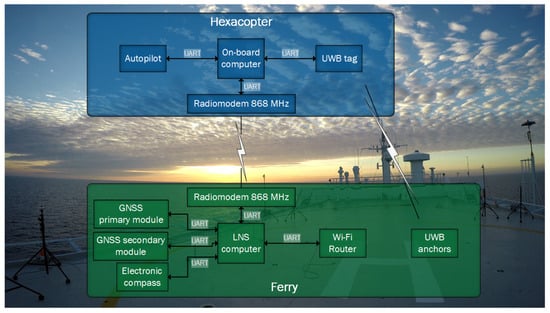
Figure 1.
Overview diagram of the tethered hexacopter system.
2.1. Tethered Multicopter
The platform carrying the proposed system was an unmanned aerial vehicle of the multirotor helicopter type. After analyzing the aspects of reliability and lifting capacity in the design phase, it was decided to use a hexarotor configuration. This offered a good combination of drive redundancy and compact dimensions. The hexarotor is shown in Figure 2.

Figure 2.
Multirotor in six-arm configuration.
In Figure 2, the frame of the multicopter (Figure 2A); one of the six arms (Figure 2B); the drive unit consisting of a propeller, a BLDC motor, and an electronic speed controller (Figure 2C); the converter power supply system (Figure 2D); the landing gear (Figure 2E); and the control system comprising an autopilot with a GNSS receiver (Figure 2F) are presented.
This unmanned aerial vehicle was characterized by the fact that it was powered by wire from the ship’s deck. Electricity was transmitted via a special cable from a ground source to dedicated electricity converters onboard the UAV. In addition, the hexarotor had a battery buffer in the event of damage to the tether, so that it was able to perform a quick but controlled landing. The weight of the helicopter, depending on the optoelectronic equipment and the length of the power cable, oscillated between 10.5 and 13.5 kg. The demand for electricity in the hover phase, depending on the prevailing weather conditions, was 1500–2000 W. At peak power consumption, which occurred during the take-off phase and the fight against turbulence, the multirotor could consume up to 3.6 kW. The main specifications of the multirotor unmanned aerial vehicle are listed in Table 1.

Table 1.
Multirotor basic characteristics.
The hexacopter could be controlled manually from the level of the remote control apparatus and the pilot-operator, or automatically from the level of the computer, in which case the operator performed only a supervisory function. The unmanned aerial system (with other components described below) on the helipad deck of the “Wolin” ferry is shown in Figure 3.
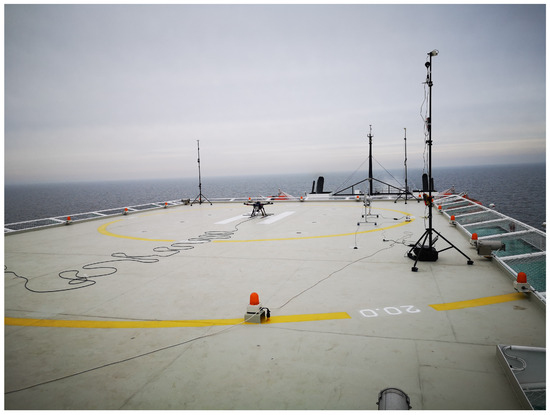
Figure 3.
Tethered hexarotor with other UAS components on the ferry’s top deck.
2.2. Tether Unwinder
The design of the cord unwinder was a challenge because of the desired altitude of the flight mission and the hexacopter’s power consumption. To achieve a reasonable range of view for the onboard vision system, the flight altitude could be no less than 50 m. Therefore, the total cord length had to also be at least 50 m. On the other hand, the six motors of the hexacopter consumed about 3 kW of power. Hence, the weight of the power cord to be lifted by the hexacopter as payload was about 2.2 kg. It should be noted that the power cord was specially selected for this application. To provide a constant unwinding and winding speed, and to ensure power cord tension regardless of the current length of its unwound part, the cord had to be wound evenly on the main roll. Thus, the structure of the power cord unwinder had to meet these specifications. It is shown in Figure 4.

Figure 4.
Structure of the power cord unwinder: 1—frame, 2—winding roll, 3—guiding trolley with tension sensor (potentiometer), 4—AC asynchronous triple-phase motor, 5—belt transmissions, 6—damper, 7—50 m of power cord. On the right-hand side, there is a picture that presents the concept of tension measurement by the potentiometer.
A guiding trolley ➂ mounted on a screw moved proportionally to the length of the unwound/wound power cord ➆, in a way that guaranteed that the cord would be wound coil by coil on a single layer. This was crucial because the 1 AWG wires of the power cord could be temporarily overloaded and would have to be cooled by the air (the supply voltage was 230 VAC). The openwork structure of the roll with the power cord helped with this. On the other hand, a power cord with 1.5 wires would be too heavy. The weight of the entire power cord of 50 m was about 2.2 kg. The roll ➁ with the power cord was driven by a belt transmission ➄ powered by a triple-phase AC asynchronous motor ➃ controlled by a single-phase inverter. A dancer roll on the guiding trolley’s end rotated a potentiometer, which was connected to the inverter’s speed input. The position of the potentiometer decided both the speed and direction of the roll’s rotation. A pulling spring rotated the potentiometer to the winding position of the cord with maximal speed. Applying the required tension to the dancer’s roll moved the potentiometer’s slider to the neutral position, stopping the unwinding or winding. Excessive tension moved the potentiometer’s slider to the unwinding position. In this way, tension was applied to the power cord by the ascending or descending UAV, switching the unwinder between winding and unwinding to provide the desired tension value. To reduce tension oscillations and secure the unwinder against sudden jerks of the power cord, a damper ➅ was installed on the unwinder’s frame ➀.
2.3. Navigational Equipment for Landing Pad Position Tracking
This subsection provides a description of the navigational equipment required to implement precision UAV navigation. This equipment included a landing pad navigation station, an onboard computer, and an autopilot.
- Landing pad navigation station
The landing pad navigation station (LNS) served as a command, measurement, and communication apparatus. Its primary functions included measuring the navigation variables of the landing pad, managing the unmanned aerial vehicle (UAV)’s flight, and exchanging data with the UAV’s onboard computer through a radio link. The navigation variables measured by the LNS included the landing pad’s current position in the WGS-84 reference system, velocity, and heading. The LNS was responsible for transmitting take-off and landing directives to the UAV and exchanging navigation data with the UAV’s onboard computer.
The landing pad navigation station is presented in Figure 5. The station comprised a main computer (see ➀ in Figure 5), two GNSS modules with antennas (primary ➁ and secondary ➂), an electronic compass ➃, and a radio module ➅ for communication between the LNS and the UAV. The station also featured a Wi-Fi router ➄ to establish a service or supervisory connection with the main computer. The structural framework of the LNS was constructed using aluminum profiles connected by mounting brackets and captive nuts. Figure 5 presents the key dimensions of the station.
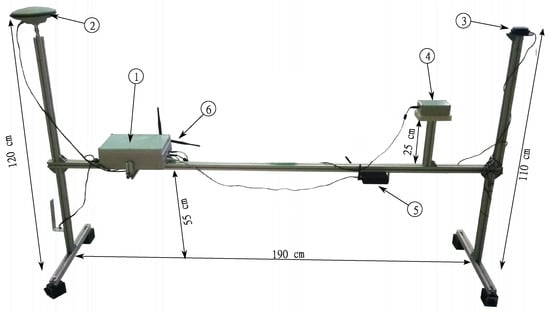
Figure 5.
Landing pad navigation station: 1—main computer; 2,3—GNSS modules with antennae; 4—electronic compass; 5—Wi-Fi router; 6—radio module.
All measuring devices within the LNS were linked to the computing unit located inside the main computer ➀. The hardware platform of the computing unit was an embedded Kontron computer [27]. The navigation system was controlled by a dedicated application that ran on the computing unit. This application acted as the UAV’s ground controll system (GCS) software, responsible for collecting measurement data from the station and managing the entire flight of the aircraft.
The primary GNSS module determined the position and velocity of the landing pad in the WGS-84 reference system. Meanwhile, the secondary GNSS module calculated the heading of the landing pad by analyzing the positions of both the primary and secondary GNSS module antennas. Spherical trigonometric relationships were used to compute the heading accurately within approximately . To achieve this accuracy, the secondary GNSS operated in RTK (real-time kinematic) moving-base mode. The GNSS modules were interconnected via UART—the primary GNSS transmitted RTCMs to the second GNSS. Furthermore, the separation distance between the GNSS antennas had to exceed 1 m [28]. The RTK functionality was delivered by GNSS U-blox modules [28]. To ensure system reliability when the RTK mode was unavailable, such as during adverse weather conditions, the navigation station included an electronic compass [29].
- Onboard computer
The onboard computer served as a crucial component, enabling the execution of the positioning and navigation of the UAV. It was tasked with obtaining and filtering accurate relative positioning data based on the UAV’s and base station’s GNSS coordinates. This estimate was further enhanced by including position information from the local positioning system (the UWB system). In order to provide this functionality, the onboard computer serviced the UWB tag mounted on the airframe. The computer operated an ROS-based framework that used a Mavlink bridge to forward the messages between the autopilot and the ground control station.
The Odroid onboard computer and the Pixhawk autopilot communicated via the UART protocol. To establish a downstream connection with the ground station, a radio link was employed, utilizing the serial protocol. Additionally, an optional Wi-Fi connection was available to facilitate diagnostics and system performance testing. The UWB receiver was connected with the onboard computer via a USB.
The ROS framework used to implement the positioning and navigational functionalities consisted of several components. A diagram of these components and their interactions is shown in Figure 6.

Figure 6.
Diagram of the onboard computer framework.
The components can be briefly described as follows. The mavlink bridge component forwarded the messages sent upstream from the LNS to the autopilot and extracted information about the base station’s position and the desired UAV position from additional custom packets inserted into the stream. The bridge also forwarded downstream packets from the autopilot to the LNS and extracted the state information of the UAV. The state information, including the position estimate obtained through the UWB component, was processed in the state estimation component, where the precise position of the UAV with respect to the base station was calculated. The state estimate was further used by the navigation and command component to compute the desired steering of the UAV. The additional auxiliary communication component was also available to process diagnostic information and logging.
- Autopilot
Although the autopilot directly controlled the flight of the UAV by managing its six motors, communication between the LNS and the UAV did not occur directly with the autopilot itself. Instead, the LNS computing unit communicated with the UAV’s onboard computer. The onboard computer played a crucial role in integrating data from the positioning system and establishing communication with the autopilot. Essentially, the LNS station transmitted take-off and landing orders directly to the autopilot through the UAV’s onboard computer. Meanwhile, the UAV’s onboard computer was responsible for determining the tracking error between the UAV’s actual position and the estimated position provided by the LNS. This information, including the estimated position and velocity from the LNS, was then relayed to the control loop of the autopilot.
The autopilot that managed the drone’s operation was the Pixhawk PX4 [30]. To regulate the altitude and heading of the UAV, the standard control algorithm implemented in the autopilot firmware was utilized. However, achieving control over the horizontal position (x, y) required making adjustments to the flight control code. In the standard PX4 multicopter control architecture, the setpoint velocity is determined based on the setpoint position , as can be seen in Figure 7. This approach is suitable when the setpoint position does not change over time. In our scenario, the ferry’s helipad was in constant horizontal motion, so the drone’s setpoint position was also constantly changing over time. To remove the offset in the drone’s position relative to the helipad, it was essential to also include in the control loop the velocity of the helipad. Therefore, the control loop for the horizontal motion of the drone took into account both the relative position error between the UAV and the LNS and the horizontal velocity of the landing pad. This was achieved by bypassing the Position Control block for horizontal control, as shown in Figure 7.
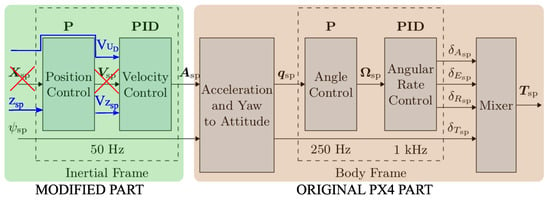
Figure 7.
Modified autopilot control architecture [31].
The altered control framework of the PX4 autopilot, with the relevant modifications highlighted in red and blue, is depicted in Figure 7. The key distinction from the original architecture was that the desired horizontal speed of the UAV was fed directly into the Velocity Control block.
2.4. UWB Positioning System
The local positioning system was developed using ultra-wideband (UWB) technology and served as an integral component within the relative positioning algorithm. The UWB-based positioning system utilized in the following application consisted of eight anchors, which were organized as depicted in Figure 8. To accurately estimate position, this system employed a technique known as lateration, which relies on measuring distances. It used two types of ranging devices: anchors placed stationarily at the landing pad, and tags mounted on the unmanned aerial vehicles (UAVs). By integrating these distance measurements with established anchor positions, precise calculations could be made to determine each tag’s specific location.
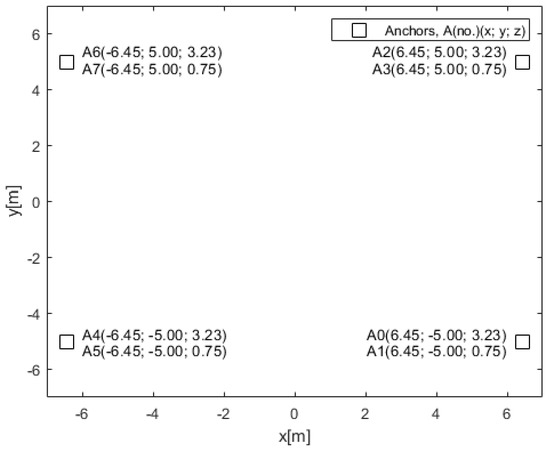
Figure 8.
Layout of the UWB system.
To address the specific requirements of fast-moving flying objects and the integration of positioning systems, a specialized structure for the positioning algorithm was implemented. Three distinct stages could be distinguished in the aforementioned algorithm, as illustrated in Figure 9.
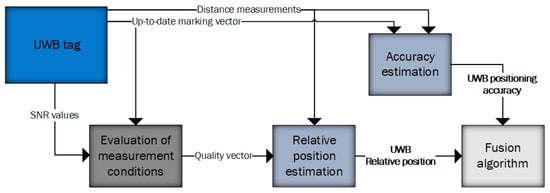
Figure 9.
Dataflow of the adaptive UWB positioning algorithm [7].
One of the primary concerns in the mentioned application revolved around the possibility of the UAV exceeding the serviceable range of measurement in the UWB devices. In such cases, some or all of the distance measurements may have become unavailable. Another issue arose when the distance between the measuring devices became too close to the maximum range that could be measured, resulting in intermittent distance measurements and highly distorted values. Furthermore, obstacles like cables, trees, the UAV itself, humans, or terrain could obstruct the radio signal, affecting distance measurements. To overcome these challenges, the UWB-based positioning algorithm incorporated an evaluation of the distance measurement quality in its initial stage.
When the first stage finished, every distance measurement was classified into one of three categories: measurement taken without any disturbances, measurement affected by poor conditions, or non-usable measurement. The quality of each measurement was assessed by utilizing the update flag and the signal-to-noise ratio (SNR) value, which were transmitted within the data frame by the UWB modules used in the positioning system.
During the initial step, the update flag was carefully analyzed. In the update flag, a dedicated bit was assigned to each measurement, with a value of 0 indicating the inability to obtain the measurement between a specific anchor and tag. Subsequently, the SNR parameter was evaluated. Measurements captured under unfavorable conditions were determined by evaluating the ratio between the signal-to-noise ratio (SNR) and the distance. If this ratio fell below a predefined threshold, the measurement was considered to have been taken in less-than-optimal conditions. Measurements with an SNR value lower than another threshold were considered non-usable. During testing, the threshold of the SNR was defined at dBm. It is important to note that when the SNR value decreased below −20 dBm, the measurements tended to be inconsistent and significantly less accurate [32,33]. To address this phenomenon, the threshold was intentionally set 2 dBm higher than the observed boundary. This adjustment helped mitigate the impact of the discontinuity and accuracy issues caused by low SNR values. By setting the threshold at dBm, positioning ranges exceeding 35 m could be achieved while simultaneously meeting the primary objective to prevent substantial error spikes in the results, as they had the potential to compromise flight stability.
The second stage of the algorithm heavily relied on the evaluated distance measurements, which served as vital inputs for the robust extended Kalman filter. This filter played a crucial role in processing and incorporating measurements to estimate the tag’s coordinates accurately. This adaptive filter could effectively handle varying numbers of inputs in subsequent steps, ensuring the reliable estimation of the tag’s coordinates. For the reliable estimation of the tag’s coordinates, a minimum of four usable distance measurements was required.
During the final stage, the accuracy of the position calculation was evaluated. The evaluation process took into careful consideration various factors, including the number of accurate measurements, the quality and reliability of those measurements, and the distance between the anchor and the tag. These critical aspects were thoroughly assessed to ensure the validity and effectiveness of the evaluation. The adaptive UWB-based positioning system provided the estimation of the UAV’s relative position, along with an assessment of its accuracy, to the algorithm performing the integration of the data provided from different measurement systems in order to output the final UAV position with respect to the position of the landing pad. This approach ensured that UWB measurements were excluded during the integration stage if the UWB system was unable to estimate the UAV’s position. By considering the reliability of the UWB system’s estimations, the integration stage selectively incorporated measurements from other reliable positioning systems. This exclusion helped maintain the accuracy and integrity of the integrated position estimation by avoiding the inclusion of potentially unreliable or erroneous data. As a result, the integration algorithm could generate more robust and trustworthy estimates of the UAV’s position by leveraging the most reliable and accurate sensor information available.
3. Tests on the Ferry in Real Maritime Conditions
The tests were carried out in the winter season in February. They took place on a real facility—the “Wolin” ferry traveling from Swinoujscie (Poland) to Trelleborg (Sweden) according to its daily schedule. During the cruise, despite the fact that it lasted about 7 h, the convenient window for the test was very narrow due to, e.g., leaving and arriving at port, passing wind farms or forbidden zones, bad weather, and dusk (when flight tests should not be carried out). During the window of possible tests, additional calibrations or parameter changes often had to be performed, which took up valuable time. Finally, on a given day, six flights of different durations and altitudes were conducted. The hexarotor in flight above the ferry deck in real sea conditions is shown in Figure 10. The ambient conditions during the aerial mission were as follows:
- Average temperature: 9 °C;
- Relative wind speed: 11–18 m/s;
- Gusts of wind: up to 22 m/s;
- Cloudiness: 80%;
- Humidity: 74%.
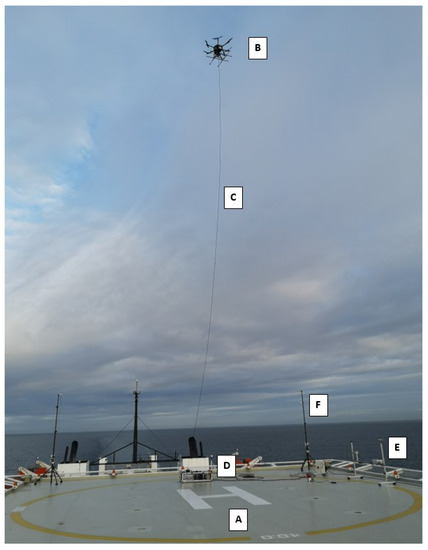
Figure 10.
Tethered hexacopter during flight tests.
In Figure 10, the ship’s helipad deck (Figure 10A), the multirotor in follow-me flight mode above the ship’s deck (Figure 10B), the UAV power cord transmitting electricity from the vessel’s deck (Figure 10C), the unwinder of the power cord (Figure 10D), the navigation station (Figure 10E), and one of the masts of the local UWB navigation system (Figure 10F) are presented.
4. Results
During the ferry cruise described above, a number of hexarotor flight tests were carried out to check the most important components of the UAV system (local control and stabilization system, positioning system, navigation system, landing-pad-following system, etc.). The results of two sample tests are shown in Figure 11, Figure 12, Figure 13, Figure 14, Figure 15, Figure 16, Figure 17, Figure 18, Figure 19 and Figure 20. The first test presented was conducted to verify if the tethered hexacopter followed the landing pad and ferry over a long distance and in difficult weather conditions. The second trial was designed to test the quality of hexacopter altitude tracking in a simulated UAV observation altitude change scenario. Figure 11 shows the 3D hexarotor trajectory realized during the first test. The take-off and landing points as well as the climb and descent curves are presented and can easily be identified. The total distance covered by the hexarotor during this test was 2.26 km. The average speed over this distance was 23.5 km/h. The hexacopter’s trajectory, in the east-north-up (ENU) local coordinate system, is also shown in Figure 12. The UAV’s estimated position is compared with the desired trajectory. The hexarotor, despite the difficult conditions, correctly and accurately followed the desired trajectory. Additionally, the take-off and landing setpoints with current values are also marked in Figure 12. The hexarotor’s attitude, expressed by roll, pitch, and yaw angles, is shown in Figure 13. The roll angle during the entire cruise was kept at about 8 degrees, while the pitch angle was about degrees. The yaw angle was about 150 degrees, except for the take-off and landing phases, when the hexarotor was close to the ship’s metal deck. The ship’s large metal superstructure distorted the readings of the UAV’s onboard magnetometer. The linear velocities of the propeller are shown in Figure 14. These velocities were used as control signals in the landing pad tracking system. In addition, the ground speed is shown for comparison. The hexarotor followed the desired speed values very precisely, except for the critical take-off phase due to disturbances of the magnetometer and disturbances from gusts of wind, which were intensified at relatively low altitudes close to the deck (air streams were reflected from the deck surface and hit the hexarotor—the ground effect). The magnetometer readings during the test are shown in Figure 15. It is easy to see the effect of the proximity of the vessel’s metal deck on the operation of the magnetometer and the determination of the yaw angle.
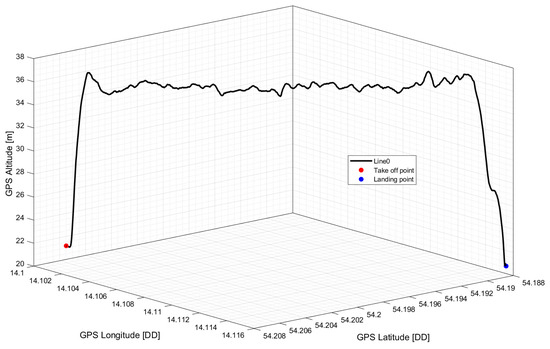
Figure 11.
Tethered hexacopter trajectory (GNSS) during the long-term following test.
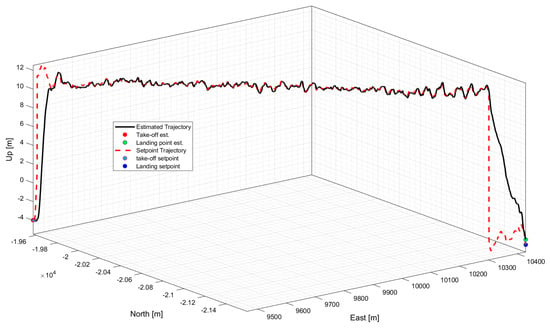
Figure 12.
Tethered hexacopter trajectory (local ENU frame) during the long-term following test.
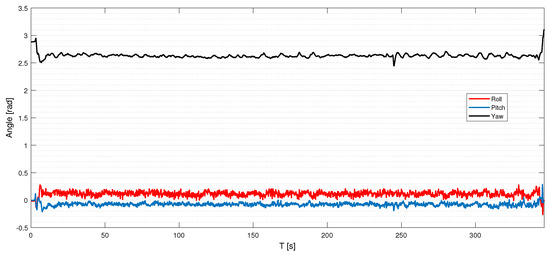
Figure 13.
Tethered hexacopter attitude during the long-term following test.
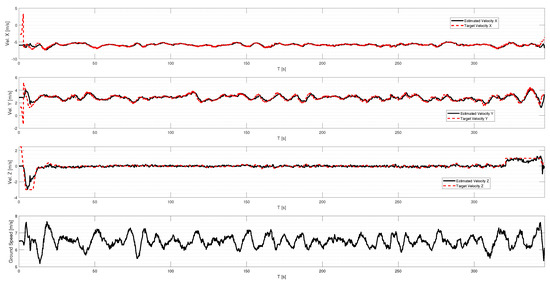
Figure 14.
Tethered hexacopter linear velocities and ground speed during the long-term following test.
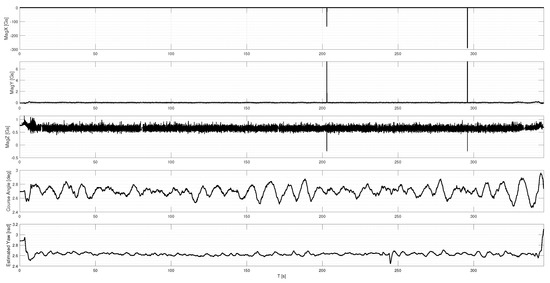
Figure 15.
Tethered hexacopter magnetometer readings and course angle during the long-term following test.
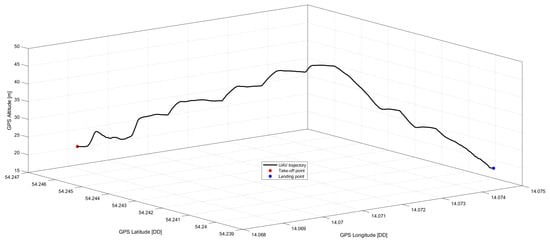
Figure 16.
Tethered hexacopter trajectory (GNSS) during the altitude following test.

Figure 17.
Tethered hexacopter trajectory (local ENU frame) during the altitude following test.
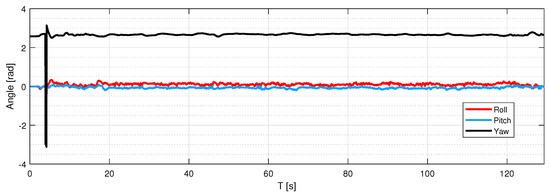
Figure 18.
Tethered hexacopter attitude during the altitude following test.
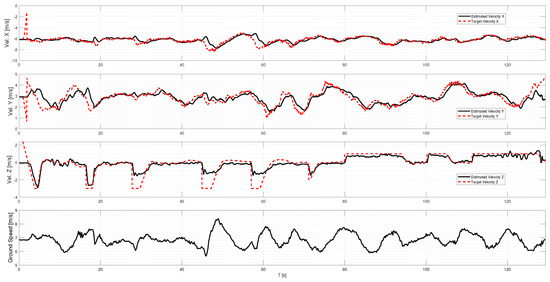
Figure 19.
Tethered hexacopter linear velocities and ground speed during the altitude following test.
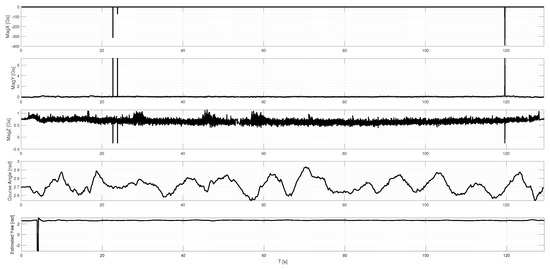
Figure 20.
Tethered hexacopter magnetometer readings and course angle during the altitude following test.
The second test involved checking the hexacopter and its navigation system in an observation scenario at various altitudes under difficult sea conditions. Changing the flight altitude (ascending, descending) while following the vessel in windy conditions and operating from the vessel’s helipad was a challenge. The vessel’s structure intensified wind disturbances and gusts, and numerous air chimneys were noted in the vicinity of the vessel’s landing pad. Similarly to the results of the first long-distance test, the UAV’s trajectory and the most important flight parameters are shown in Figure 16, Figure 17, Figure 18, Figure 19 and Figure 20. In Figure 16, the hexacopter’s trajectory during the second test is presented. It is easy to see the changes in altitude intentionally triggered in the control system. During the second test, the hexacopter covered a distance of almost 900 m, with an average speed of 25 km/h. The hexacopter’s trajectory in the ENU local coordinate system is also shown in Figure 17. Here, the set values of the trajectory and the estimated position in the local frame in the ENU reference system can easily be compared. It can be seen that the quality of tracking the desired trajectory was satisfactory, despite the difficult weather and environmental conditions. The roll, pitch, and yaw angles during the second test are shown in Figure 18. The average value of the roll angle during the test was 6 degrees, while the pitch angle was about degrees. The yaw angle during the entire test was 150 degrees, with a jump to degrees in the initial phase of the test (just after the start). This was caused by large changes in the magnetic field in close proximity to the vessel’s metal deck. Control system quality evaluation could also be carried out by analyzing linear velocities (desired and measured values). These are shown in Figure 19. The control system followed the setppoint properly. The largest changes in the setpoint could be seen in the z-axis velocity component. This was caused by forced changes in the altitude setpoint. As in the previous test, the magnetometer readings are presented in Figure 20. It is easy to see the effect of the proximity of the vessel’s metal deck on the operation of the magnetometer and the determination of the yaw angle.
5. Conclusions
Tests in real conditions are always the best way to verify the correctness and effectiveness of designed systems, especially flying systems such as UAVs. Assumptions made during the design process are usually reformulated, and valuable knowledge about the tested object is collected. In the case of the tested tethered hexacopter, the flights at sea during a standard “Wolin” ferry voyage made it possible to identify some exciting issues.
The most important issue concerned the magnetometer readings on the ferry’s landing pad. Varying drift from the real magnetic north, which decreased with a flight altitude increment, was observed, especially on the plots of the magnetometer z-axis readings just after take-off and just before landing (Figure 15 and Figure 20, respectively). Moreover, the z-axis readings of the magnetometer were very noisy in comparison to the x- and y-axis readings. Of course, the problem’s source lay in the material from which the ferry’s structure was made. Steel is a ferromagnetic material, which interferes with the weak magnetic field of the Earth. The magnetometer was the most crucial device among the hexacopter onboard equipment, because it was the only source of heading that was required to track the landing pad’s position while the ferry was cruising. At the low cruise speed of the ferry, the GNSS heading readings were unreliable. During the tests, a solution to this problem was found, which included magnetometer recalibration before each take-off. Thus, our conclusion was that the automated process of flight management, especially if it has to be carried out by the computer of an autonomous vessel, must include a flight preparation phase responsible for magnetometer tests and recalibration.
Another important issue arose from air vortices around the landing pad, at an altitude of up to 5 m. These were generated by the wind’s air mass reflected from the vessel’s side and other equipment located around the landing pad and by the airflow related to the vessel’s movement. In the case of the ferry, its landing pad was almost at the top of the ferry’s body, just behind the captain’s bridge, and these were ideal conditions for such vortices. Because of these vortices, the take-off phase was extremely unstable up to 5 m above the surface of the landing pad. There was no possibility of mounting wind deflectors around the landing pad, so the only way to reduce the crash risk was to perform take-off with the maximum vertical speed to jump through the vortices’ area.
During flights performed in real maritime conditions, no significant impact of the power cord’s aerodynamic drag was observed. The unwinder always provided the proper tension and required length of the cord. The only issue was related to the winding speed while the hexacopter was in freefall due to a motor fault. The winding speed was too low because it was tuned to the normal landing phase. Therefore, an emergency procedure enabling the maximum speed of the unwinder motor in the case of a fault in one of the hexacopter’s motors should be provided and launched by the flight management computer.
Thus, during the tests in real maritime conditions, the issues that could be critical in the implementation phase of the hexacopter were identified. The gathered experience and knowledge will be utilized during future projects, aiming to design UAV systems for unmanned vessels. Preparing and carrying out the tests on the “Wolin” ferry’s landing pad was highly risky, because the landing pad and the ferry’s deck were not prepared for flying UAVs. Any freefall of the tethered hexacopter was dangerous to the researchers, ferry crew, and navigation devices on the ferry deck. Thus, successful tests without any crashes must be considered a great achievement.
Author Contributions
Conceptualization, L.A., M.C., A.W., S.R., D.O., A.B. and C.K.; methodology, L.A., M.C., A.W., S.R., D.O., A.B. and C.K.; software, L.A., M.C. and A.W.; validation, L.A., M.C., A.W., S.R., D.O. and A.B.; formal analysis, L.A., M.C., A.W., S.R., D.O. and A.B.; investigation, L.A., M.C., A.W., S.R., D.O., A.B. and C.K.; resources, L.A., M.C., A.W., S.R., D.O. and A.B.; data curation, L.A., M.C., A.W., S.R., D.O. and A.B.; writing—original draft preparation, L.A., M.C., A.W., S.R., D.O., A.B. and C.K.; writing—review and editing, L.A., M.C., A.W., S.R., D.O., A.B., Z.K. and C.K.; visualization, L.A., M.C., A.W., S.R., D.O. and A.B.; supervision, C.K.; project administration, C.K.; funding acquisition, L.A., M.C., A.W., S.R., D.O., A.B., C.K. and Z.K. All authors have read and agreed to the published version of the manuscript.
Funding
This work was supported by the National Center of Research and Development, Poland, as part of the project entitled “Application research in the area of navigation, control, communication and data exchange between an autonomous vessel and an aircraft”, financed by the European Regional Development Fund as part of the Smart Growth Operational Programme 2014–2020 (POIR.04.01.04-00-0025/16). This article was also supported by statutory funds of the Department of Mechanical Engineering (WZ/WM-IIM/2/2022) and statutory funds of the Department of Electrical Engineering (WZ/WE-IA/4/2023).
Institutional Review Board Statement
Not applicable.
Informed Consent Statement
Not applicable.
Data Availability Statement
Not applicable.
Conflicts of Interest
The authors declare no conflict of interest.
Abbreviations
The following abbreviations are used in this manuscript:
| AC | Alternating current |
| AC/DC | Alternating current/direct current |
| AWG | American wire gauge |
| BLDC | BrushLess direct current |
| DNN | Deep neural network |
| ENU | East-north-up |
| GAN | Generative adversarial network |
| GNSS | Global navigation satellite systems |
| IMU | Inertial measurement unit |
| LIDAR | Light detection and ranging |
| LNS | Landing pad navigation station |
| ROS | Robotic operating system |
| RTCM | Real-time correction message |
| RTK | Real-time kinematics |
| SAR | Search and rescue |
| SNR | Signal-to-noise ratio |
| SR | Super-resolution |
| UART | Universal asynchronous receiver-transmitter |
| UAV | Unmanned aerial vehicle |
| USB | Universal serial bus |
| USV | Unmanned sea vehicle |
| UWB | Ultra-wideband |
| VAC | Volts alternating current |
| VTOL | Vertical takeoff and landing |
| WGS-84 | World Geodetic System ’84 |
References
- Wei, L.; Tao, Z.; Shengjun, H.; Kaiwen, L. A hybrid optimization framework for UAV reconnaissance mission planning. Comput. Ind. Eng. 2022, 173, 108653. [Google Scholar] [CrossRef]
- Santos, N.P.; Rodrigues, V.B.; Pinto, A.B.; Damas, B. Automatic Detection of Civilian and Military Personnel in Reconnaissance Missions using a UAV. In Proceedings of the 2023 IEEE International Conference on Autonomous Robot Systems and Competitions (ICARSC), Tomar, Portugal, 26–27 April 2023; pp. 157–162. [Google Scholar] [CrossRef]
- Ahmadian, N.; Lim, G.J.; Torabbeigi, M.; Kim, S.J. Smart border patrol using drones and wireless charging system under budget limitation. Comput. Ind. Eng. 2022, 164, 107891. [Google Scholar] [CrossRef]
- Namburu, A.; Selvaraj, P.; Mohan, S.; Ragavanantham, S.; Eldin, E.T. Forest Fire Identification in UAV Imagery Using X-MobileNet. Electronics 2023, 12, 733. [Google Scholar] [CrossRef]
- Li, Y.; Yuan, H.; Wang, Y.; Xiao, C. GGT-YOLO: A Novel Object Detection Algorithm for Drone-Based Maritime Cruising. Drones 2022, 6, 335. [Google Scholar] [CrossRef]
- Muttin, F. Umbilical deployment modeling for tethered UAV detecting oil pollution from ship. Appl. Ocean Res. 2011, 33, 332–343. [Google Scholar] [CrossRef]
- Kownacki, C.; Ambroziak, L.; Ciezkowski, M.; Wolniakowski, A.; Romaniuk, S.; Bożko, A.; Oldziej, D. Precision Landing Tests of Tethered Multicopter and VTOL UAV on Moving Landing Pad on a Lake. Sensors 2023, 23, 2016. [Google Scholar] [CrossRef]
- Colomina, I.; Molina, P. Unmanned aerial systems for photogrammetry and remote sensing: A review. ISPRS J. Photogramm. Remote Sens. 2014, 92, 79–97. [Google Scholar] [CrossRef]
- Agrafiotis, P.; Skarlatos, D.; Georgopoulos, A.; Karantzalos, K. Shallow Water Bathymetry Mapping from UAV Imagery Based on Machine Learning. Int. Arch. Photogramm. Remote Sens. Spat. Inf. Sci. 2019, XLII-2/W10, 9–16. [Google Scholar] [CrossRef]
- Burdziakowski, P. Increasing the Geometrical and Interpretation Quality of Unmanned Aerial Vehicle Photogrammetry Products Using Super-resolution Algorithms. Remote Sens. 2020, 12, 810. [Google Scholar] [CrossRef]
- Dhaliwal, S.S.; Ramirez-Serrano, A. Control of an unconventional VTOL UAV for search and rescue operations within confined spaces based on the Marc control architecture. In Proceedings of the 2009 IEEE International Workshop on Safety, Security Rescue Robotics (SSRR 2009), Denver, CO, USA, 3–6 November 2009; IEEE: Piscataway, NJ, USA, 2009; pp. 1–6. [Google Scholar]
- Fabiani, P.; Fuertes, V.; Piquereau, A.; Mampey, R.; Teichteil-Königsbuch, F. Autonomous flight and navigation of VTOL UAVs: From autonomy demonstrations to out-of-sight flights. Aerosp. Sci. Technol. 2007, 11, 183–193. [Google Scholar] [CrossRef]
- Okulski, M.; Ławryńczuk, M. A Small UAV Optimized for Efficient Long-Range and VTOL Missions: An Experimental Tandem-Wing Quadplane Drone. Appl. Sci. 2022, 12, 7059. [Google Scholar] [CrossRef]
- Lewicka, O.; Specht, M.; Specht, C. Assessment of the Steering Precision of a UAV along the Flight Profiles Using a GNSS RTK Receiver. Remote Sens. 2022, 14, 6127. [Google Scholar] [CrossRef]
- Dąbrowski, P.S.; Specht, C.; Specht, M.; Burdziakowski, P.; Makar, A.; Lewicka, O. Integration of Multi-source Geospatial Data from GNSS Receivers, Terrestrial Laser Scanners, and Unmanned Aerial Vehicles. Can. J. Remote Sens. 2021, 47, 621–634. [Google Scholar] [CrossRef]
- Yang, B.; Yang, E. A Survey on Radio Frequency based Precise Localisation Technology for UAV in GPS-denied Environment. J. Intell. Robot. Syst. 2021, 103, 38. [Google Scholar] [CrossRef]
- Paul, H.; Miyazaki, R.; Kominami, T.; Ladig, R.; Shimonomura, K. A Versatile Aerial Manipulator Design and Realization of UAV Take-Off from a Rocking Unstable Surface. Appl. Sci. 2021, 11, 9157. [Google Scholar] [CrossRef]
- Tang, H.; Zhang, D.; Gan, Z. Control System for Vertical Take-Off and Landing Vehicle’s Adaptive Landing Based on Multi-Sensor Data Fusion. Sensors 2020, 20, 4411. [Google Scholar] [CrossRef]
- Chang, C.-W.; Lo, L.-Y.; Cheung, H.C.; Feng, Y.; Yang, A.-S.; Wen, C.-Y.; Zhou, W. Proactive Guidance for Accurate UAV Landing on a Dynamic Platform: A Visual–Inertial Approach. Sensors 2022, 22, 404. [Google Scholar] [CrossRef]
- Grlj, C.G.; Krznar, N.; Pranjić, M. A Decade of UAV Docking Stations: A Brief Overview of Mobile and Fixed Landing Platforms. Drones 2022, 6, 17. [Google Scholar] [CrossRef]
- Acevedo, J.J.; García, M.; Viguria, A.; Ramón, P.; Arrue, B.C.; Ollero, A. Autonomous Landing of a Multicopter on a Moving Platform Based on Vision Techniques. In Proceedings of the ROBOT 2017: Third Iberian Robotics Conference, ROBOT 2017, Sevilla, Spain, 22–24 November 2017; Ollero, A., Sanfeliu, A., Montano, L., Lau, N., Cardeira, C., Eds.; Advances in Intelligent Systems and Computing. Springer: Cham, Sweitzerland, 2017; Volume 694. [Google Scholar]
- Shao, G.; Ma, Y.; Malekian, R.; Yan, X.; Li, Z. A Novel Cooperative Platform Design for Coupled USV–UAV Systems. IEEE Trans. Ind. Inform. 2019, 15, 4913–4922. [Google Scholar] [CrossRef]
- Narváez, E.; Ravankar, A.A.; Ravankar, A.; Emaru, T.; Kobayashi, Y. Autonomous VTOL-UAV Docking System for Heterogeneous Multirobot Team. IEEE Trans. Instrum. Meas. 2021, 70, 5500718. [Google Scholar] [CrossRef]
- Palafox, P.R.; Garzón, M.; Valente, J.; Roldán, J.J.; Barrientos, A. Robust Visual-Aided Autonomous Takeoff, Tracking, and Landing of a Small UAV on a Moving Landing Platform for Life-Long Operation. Appl. Sci. 2019, 9, 2661. [Google Scholar] [CrossRef]
- Alarcón, F.; García, M.; Maza, I.; Viguria, A.; Ollero, A. A Precise and GNSS-Free Landing System on Moving Platforms for Rotary-Wing UAVs. Sensors 2019, 19, 886. [Google Scholar] [CrossRef] [PubMed]
- Aissi, M.; Moumen, Y.; Berrich, J.; Bouchentouf, T.; Bourhaleb, M.; Rahmoun, M. Autonomous solar USV with an automated launch and recovery system for UAV: State of the art and Design. In Proceedings of the 2020 IEEE 2nd International Conference on Electronics, Control, Optimization and Computer Science (ICECOCS), Kenitra, Morocco, 2–3 December 2020; pp. 1–6. [Google Scholar]
- Kontron. pITX-E38, ULTRASMALL 2.5” Pico-ITX BOARD WITH Intel® Atom™ E38XX; Kontron: Augsburg, Germany, 2016. [Google Scholar]
- U-blox. NEO-M8P U-blox M8 High Precision GNSS Modules; No. UBX-15016656; U-blox: Thalwil, Switzerland, 2020. [Google Scholar]
- Sparton. AHRS-8, Attitude Heading Reference System; No. 12.21.17; Sparton: Schaumburg, IL, USA, 2017. [Google Scholar]
- PX4 Autopilot User Guide (Main). Available online: https://docs.px4.io/main/en/ (accessed on 29 May 2023).
- PX4 Controller Diagrams. Available online: https://docs.px4.io/main/en/flight_stack/controller_diagrams.html (accessed on 29 May 2023).
- Barral, V.; Escudero, C.J.; García-Naya, J.A. NLOS Classification Based on RSS and Ranging Statistics Obtained from Low-Cost UWB Devices. In Proceedings of the 27th European Signal Processing Conference (EUSIPCO), A Coruna, Spain, 2–6 September 2019; pp. 1–5. [Google Scholar] [CrossRef]
- Janczak, D.; Walendziuk, W.; Sadowski, M.; Zankiewicz, A.; Konopko, K.; Idzkowski, A. Accuracy Analysis of the Indoor Location System Based on Bluetooth Low-Energy RSSI Measurements. Energies 2022, 15, 8832. [Google Scholar] [CrossRef]
Disclaimer/Publisher’s Note: The statements, opinions and data contained in all publications are solely those of the individual author(s) and contributor(s) and not of MDPI and/or the editor(s). MDPI and/or the editor(s) disclaim responsibility for any injury to people or property resulting from any ideas, methods, instructions or products referred to in the content. |
© 2023 by the authors. Licensee MDPI, Basel, Switzerland. This article is an open access article distributed under the terms and conditions of the Creative Commons Attribution (CC BY) license (https://creativecommons.org/licenses/by/4.0/).